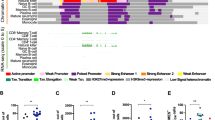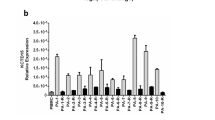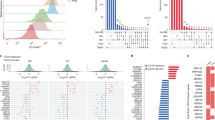Abstract
CD38, a nucleotide-metabolizing ectoenzyme and a receptor, is a negative prognostic marker for chronic lymphocytic leukemia (CLL) patients. CD38 has a genetic polymorphism, with a C → G variation in a putative E-box located in a regulatory region. E2A, the predominant E-box factor in B lymphocytes, was found to be highly expressed by CD38+ CLL patients. The highest CD38 levels scored by E2A+/G carrier patients suggested that E2A is (i) directly associated with CD38 expression, and that (ii) the binding of the transcription factor is influenced by the CD38 genotype. Chromatin immunoprecipitation indicated that E2A directly interacts with the CD38 regulatory region. Furthermore, E2A binding was stronger in the presence of the G allele. Experiments of E2A silencing led to a significant reduction of surface levels of CD38, confirming the working hypothesis. A direct functional interplay between E2A and CD38 was shown by exposing CLL cells to interleukin-2 and TLR-9 ligands, both inducers of CD38 expression. Under these conditions, CD38 upregulation was primarily conditioned by the presence of E2A and then by the G allele. The results of this study link E2A and CD38 expression within a common pathway, in which E-protein activity is required for the efficient induction of CD38 transcription.
This is a preview of subscription content, access via your institution
Access options
Subscribe to this journal
Receive 12 print issues and online access
$259.00 per year
only $21.58 per issue
Buy this article
- Purchase on Springer Link
- Instant access to full article PDF
Prices may be subject to local taxes which are calculated during checkout





Similar content being viewed by others
References
Chiorazzi N, Rai KR, Ferrarini M . Chronic lymphocytic leukemia. N Engl J Med 2005; 352: 804–815.
Dal-Bo M, Bertoni F, Forconi F, Zucchetto A, Bomben R, Marasca R et al. Intrinsic and extrinsic factors influencing the clinical course of B-cell chronic lymphocytic leukemia: prognostic markers with pathogenetic relevance. J Transl Med 2009; 7: 76.
Deaglio S, Vaisitti T, Aydin S, Ferrero E, Malavasi F . In-tandem insight from basic science combined with clinical research: CD38 as both marker and key component of the pathogenetic network underlying chronic lymphocytic leukemia. Blood 2006; 108: 1135–1144.
Malavasi F, Deaglio S, Funaro A, Ferrero E, Horenstein AL, Ortolan E et al. Evolution and function of the ADP ribosyl cyclase/CD38 gene family in physiology and pathology. Physiol Rev 2008; 88: 841–886.
Deaglio S, Aydin S, Grand MM, Vaisitti T, Bergui L, D’Arena G et al. CD38/CD31 interactions activate genetic pathways leading to proliferation and migration in chronic lymphocytic leukemia cells. Mol Med 2010; 16: 87–91.
Patten PE, Buggins AG, Richards J, Wotherspoon A, Salisbury J, Mufti GJ et al. CD38 expression in chronic lymphocytic leukemia is regulated by the tumor microenvironment. Blood 2008; 111: 5173–5181.
Jaksic O, Paro MM, Kardum Skelin I, Kusec R, Pejsa V, Jaksic B . CD38 on B-cell chronic lymphocytic leukemia cells has higher expression in lymph nodes than in peripheral blood or bone marrow. Blood 2004; 103: 1968–1969.
Deaglio S, Capobianco A, Bergui L, Durig J, Morabito F, Duhrsen U et al. CD38 is a signaling molecule in B-cell chronic lymphocytic leukemia cells. Blood 2003; 102: 2146–2155.
Willimott S, Baou M, Huf S, Deaglio S, Wagner SD . Regulation of CD38 in proliferating chronic lymphocytic leukemia cells stimulated with CD154 and interleukin-4. Haematologica 2007; 92: 1359–1366.
Rozkova D, Novotna L, Pytlik R, Hochova I, Kozak T, Bartunkova J et al. Toll-like receptors on B-CLL cells: expression and functional consequences of their stimulation. Int J Cancer 2010; 126: 1132–1143.
Ding W, Nowakowski GS, Knox TR, Boysen JC, Maas ML, Schwager SM et al. Bi-directional activation between mesenchymal stem cells and CLL B-cells: implication for CLL disease progression. Br J Haematol 2009; 147: 471–483.
Ferrero E, Malavasi F . The metamorphosis of a molecule: from soluble enzyme to the leukocyte receptor CD38. J Leukoc Biol 1999; 65: 151–161.
Ferrero E, Saccucci F, Malavasi F . The human CD38 gene: polymorphism, CpG island, and linkage to the CD157 (BST-1) gene. Immunogenetics 1999; 49: 597–604.
Gonzalez-Escribano MF, Aguilar F, Torres B, Sanchez-Roman J, Nunez-Roldan A . CD38 polymorphisms in Spanish patients with systemic lupus erythematosus. Hum Immunol 2004; 65: 660–664.
Drummond FJ, Mackrill JJ, O′Sullivan K, Daly M, Shanahan F, Molloy MG . CD38 is associated with premenopausal and postmenopausal bone mineral density and postmenopausal bone loss. J Bone Miner Metab 2006; 24: 28–35.
Jamroziak K, Szemraj Z, Grzybowska-Izydorczyk O, Szemraj J, Bieniasz M, Cebula B et al. CD38 gene polymorphisms contribute to genetic susceptibility to B-cell chronic lymphocytic leukemia: evidence from two case-control studies in Polish Caucasians. Cancer Epidemiol Biomarkers Prev 2009; 18: 945–953.
Aydin S, Rossi D, Bergui L, D’Arena G, Ferrero E, Bonello L et al. CD38 gene polymorphism and chronic lymphocytic leukemia: a role in transformation to Richter syndrome? Blood 2008; 111: 5646–5653.
Kee BL . E and ID proteins branch out. Nat Rev Immunol 2009; 9: 175–184.
Murre C . Regulation and function of the E2A proteins in B cell development. Adv Exp Med Biol 2007; 596: 1–7.
Kwon K, Hutter C, Sun Q, Bilic I, Cobaleda C, Malin S et al. Instructive role of the transcription factor E2A in early B lymphopoiesis and germinal center B cell development. Immunity 2008; 28: 751–762.
Greenbaum S, Zhuang Y . Identification of E2A target genes in B lymphocyte development by using a gene tagging-based chromatin immunoprecipitation system. Proc Natl Acad Sci USA 2002; 99: 15030–15035.
Hsu LY, Lauring J, Liang HE, Greenbaum S, Cado D, Zhuang Y et al. A conserved transcriptional enhancer regulates RAG gene expression in developing B cells. Immunity 2003; 19: 105–117.
Murre C, McCaw PS, Baltimore D . A new DNA binding and dimerization motif in immunoglobulin enhancer binding, daughterless, MyoD, and myc proteins. Cell 1989; 56: 777–783.
Deaglio S, Vaisitti T, Aydin S, Bergui L, D’Arena G, Bonello L et al. CD38 and ZAP-70 are functionally linked and mark CLL cells with high migratory potential. Blood 2007; 110: 4012–4021.
Nutt SL, Kee BL . The transcriptional regulation of B cell lineage commitment. Immunity 2007; 26: 715–725.
Murre C . Helix-loop-helix proteins and lymphocyte development. Nat Immunol 2005; 6: 1079–1086.
Van der Put E, Frasca D, King AM, Blomberg BB, Riley RL . Decreased E47 in senescent B cell precursors is stage specific and regulated posttranslationally by protein turnover. J Immunol 2004; 173: 818–827.
Jacobs Y, Vierra C, Nelson C . E2A expression, nuclear localization, and in vivo formation of DNA- and non-DNA-binding species during B-cell development. Mol Cell Biol 1993; 13: 7321–7333.
Thunberg U, Tobin G, Johnson A, Soderberg O, Padyukov L, Hultdin M et al. Polymorphism in the P2X7 receptor gene and survival in chronic lymphocytic leukaemia. Lancet 2002; 360: 1935–1939.
Wiley JS, Dao-Ung LP, Gu BJ, Sluyter R, Shemon AN, Li C et al. A loss-of-function polymorphic mutation in the cytolytic P2X7 receptor gene and chronic lymphocytic leukaemia: a molecular study. Lancet 2002; 359: 1114–1119.
Nuckel H, Frey UH, Durig J, Duhrsen U, Siffert W . Methylenetetrahydrofolate reductase (MTHFR) gene 677C>T and 1298A>C polymorphisms are associated with differential apoptosis of leukemic B cells in vitro and disease progression in chronic lymphocytic leukemia. Leukemia 2004; 18: 1816–1823.
Gryshchenko I, Hofbauer S, Stoecher M, Daniel PT, Steurer M, Gaiger A et al. MDM2 SNP309 is associated with poor outcome in B-cell chronic lymphocytic leukemia. J Clin Oncol 2008; 26: 2252–2257.
Rossi D, Rasi S, Capello D, Gaidano G . Prognostic assessment of BCL2-938C>A polymorphism in chronic lymphocytic leukemia. Blood 2008; 111: 466–468.
Quong MW, Harris DP, Swain SL, Murre C . E2A activity is induced during B-cell activation to promote immunoglobulin class switch recombination. EMBO J 1999; 18: 6307–6318.
Quong MW, Martensson A, Langerak AW, Rivera RR, Nemazee D, Murre C . Receptor editing and marginal zone B cell development are regulated by the helix-loop-helix protein, E2A. J Exp Med 2004; 199: 1101–1112.
Frasca D, Landin AM, Lechner SC, Ryan JG, Schwartz R, Riley RL et al. Aging down-regulates the transcription factor E2A, activation-induced cytidine deaminase, and Ig class switch in human B cells. J Immunol 2008; 180: 5283–5290.
Riley RL, Blomberg BB, Frasca D . B cells, E2A, and aging. Immunol Rev 2005; 205: 30–47.
Rutherford MN, LeBrun DP . Restricted expression of E2A protein in primary human tissues correlates with proliferation and differentiation. Am J Pathol 1998; 153: 165–173.
Bain G, Maandag EC, Izon DJ, Amsen D, Kruisbeek AM, Weintraub BC et al. E2A proteins are required for proper B cell development and initiation of immunoglobulin gene rearrangements. Cell 1994; 79: 885–892.
Goldfarb AN, Flores JP, Lewandowska K . Involvement of the E2A basic helix-loop-helix protein in immunoglobulin heavy chain class switching. Mol Immunol 1996; 33: 947–956.
Sayegh CE, Quong MW, Agata Y, Murre C . E-proteins directly regulate expression of activation-induced deaminase in mature B cells. Nat Immunol 2003; 4: 586–593.
Xu Z, Pone EJ, Al-Qahtani A, Park SR, Zan H, Casali P . Regulation of aicda expression and AID activity: relevance to somatic hypermutation and class switch DNA recombination. Crit Rev Immunol 2007; 27: 367–397.
Palacios F, Moreno P, Morande P, Abreu C, Correa A, Porro V et al. High expression of AID and active class switch recombination might account for a more aggressive disease in unmutated CLL patients: link with an activated microenvironment in CLL disease. Blood 2010; 115: 4488–4496.
Acknowledgements
We thank Dr E Ferrero (University of Turin, Italy) and Dr D Colomer (Hospital Clinic, Barcelona, Espana) for expert advice and assistance in setting up the experiments. The expertize of K Gizzi and F Cottino is also gratefully acknowledged. We thank Aczon srl (Bologna, Italy) for labeling monoclonal antibodies produced by the Lab of Immunogenetics. This work was supported by the Associazione Italiana Ricerca Cancro (AIRC, IG8590 and Special Program Molecular and Clinical Oncology, 5 per Mille project), the Compagnia SanPaolo, Ministero della Salute—Bando Giovani Ricercatori 2008, Ministero della Università e Ricerca—Bando Futuro in Ricerca 2009, Progetti Ricerca Interesse Nazionale (PRIN) and the Regione Piemonte. The Fondazione Internazionale Ricerche Medicina Sperimentale (FIRMS) provided financial and administrative assistance.
Author information
Authors and Affiliations
Corresponding author
Ethics declarations
Competing interests
The authors declare no conflict of interest.
Additional information
Supplementary Information accompanies the paper on the Leukemia website
Rights and permissions
About this article
Cite this article
Saborit-Villarroya, I., Vaisitti, T., Rossi, D. et al. E2A is a transcriptional regulator of CD38 expression in chronic lymphocytic leukemia. Leukemia 25, 479–488 (2011). https://doi.org/10.1038/leu.2010.291
Received:
Revised:
Accepted:
Published:
Issue Date:
DOI: https://doi.org/10.1038/leu.2010.291
Keywords
This article is cited by
-
Genetic Variations in Elements of the Oxytocinergic Pathway are Associated with Attention/Hyperactivity Problems and Anxiety Problems in Childhood
Child Psychiatry & Human Development (2024)
-
Evolving roles of CD38 metabolism in solid tumour microenvironment
British Journal of Cancer (2023)
-
Association of Toll-like receptors polymorphisms with the risk of acute lymphoblastic leukemia in the Brazilian Amazon
Scientific Reports (2022)
-
NOTCH1 mutations associate with low CD20 level in chronic lymphocytic leukemia: evidence for a NOTCH1 mutation-driven epigenetic dysregulation
Leukemia (2016)
-
Ikaros, Helios, and Aiolos protein levels increase in human thymocytes after β selection
Immunologic Research (2016)



